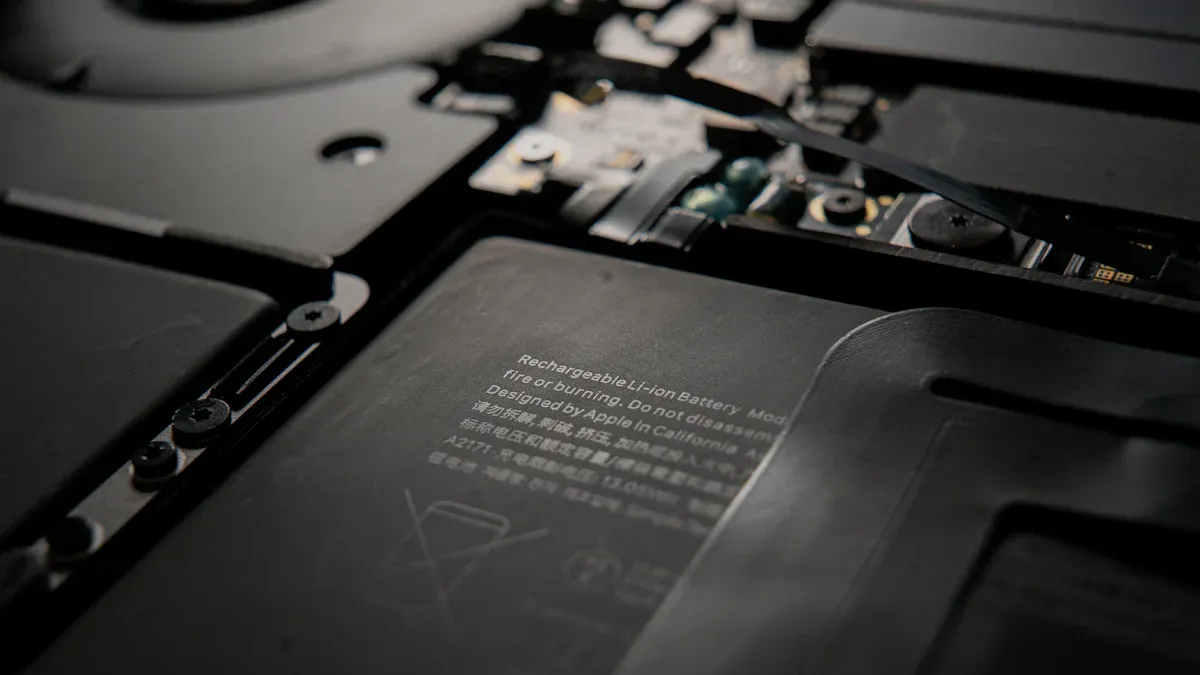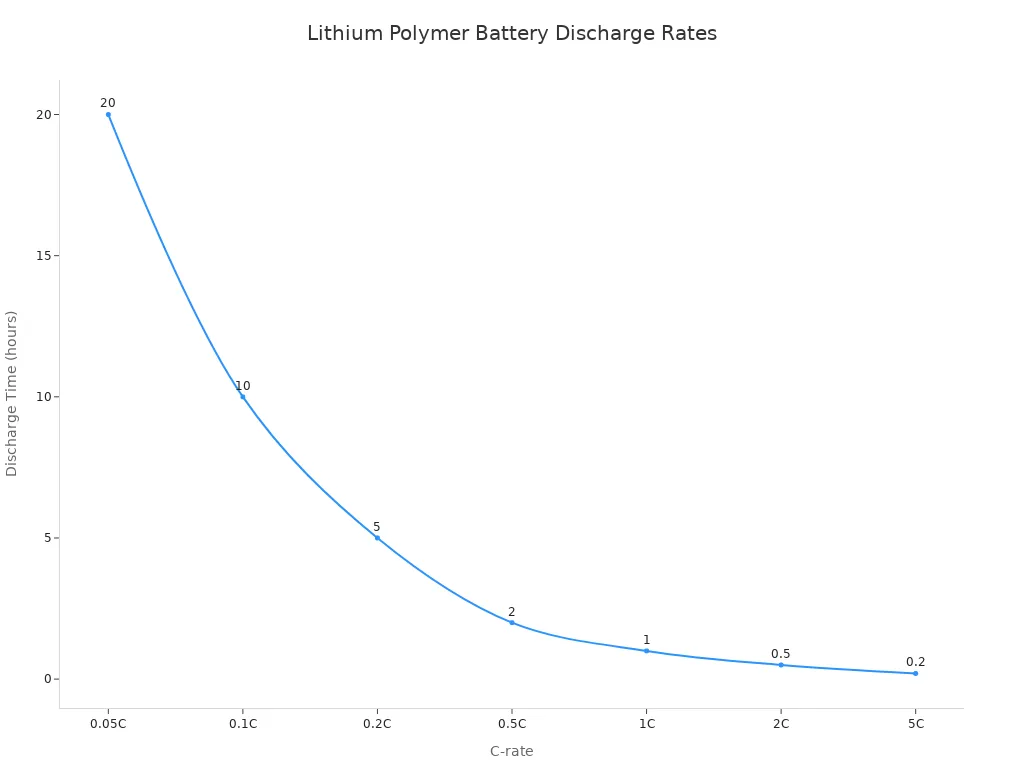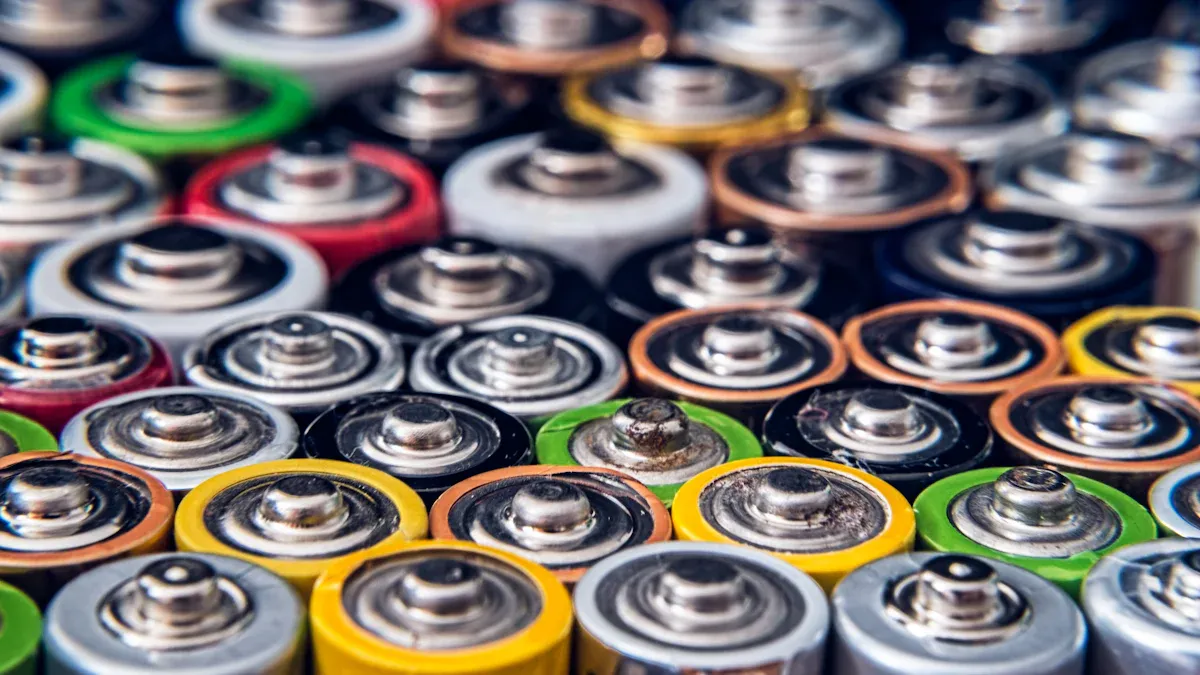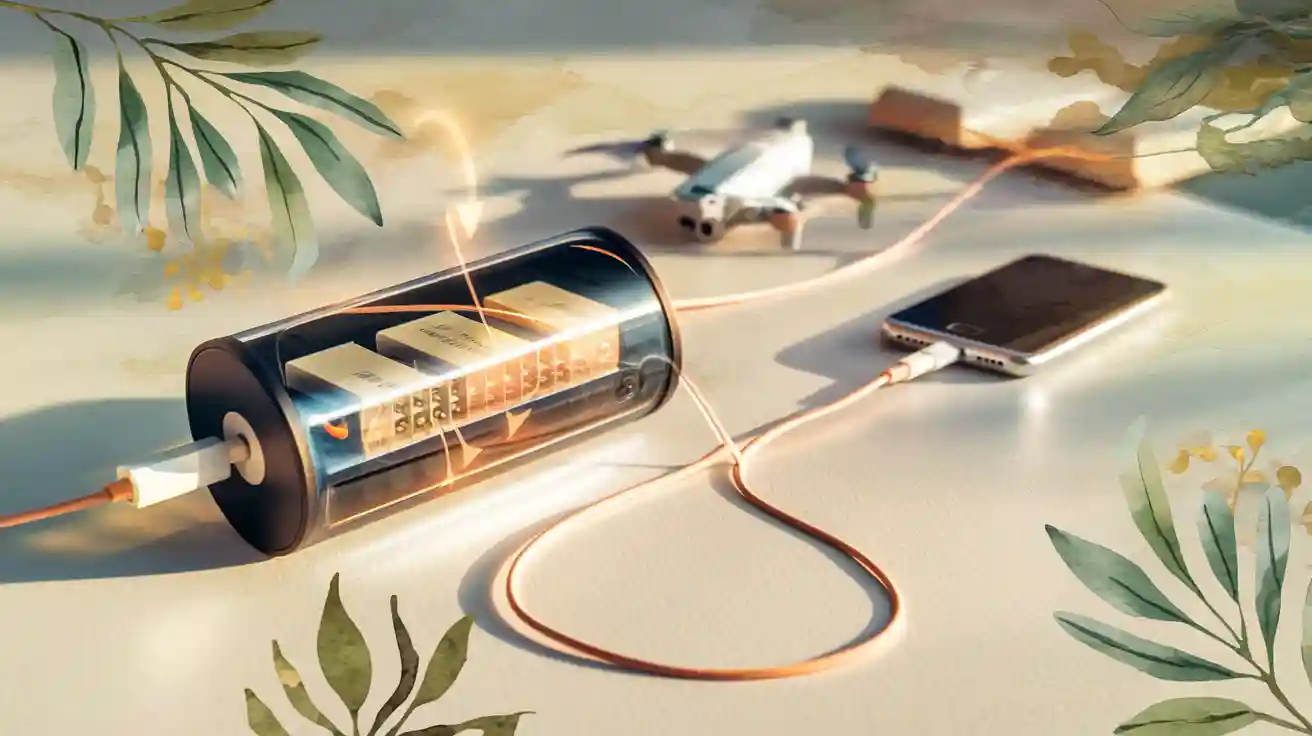What is a Lithium Polymer Battery and How Does It Work?
A lithium polymer battery, sometimes called a lithium-polymer battery, uses a solid or gel-like polymer as its electrolyte instead of a liquid. You find these batteries in modern devices because they recharge easily and offer lightweight energy storage. The polymer electrolyte comes in several types:
| Type of Polymer Electrolyte | Characteristics |
|---|---|
| Crystalline Polymer | Low conductivity |
| Dry Polymer | Non-crystalline material with dissolved salt |
| Plasticized Polymer | Contains organic additives, higher conductivity than dry polymer |
| Solvent Doped Polymer | Can have single or double phase structure depending on doping level |
Today, you see lithium polymer batteries everywhere due to their flexibility and high energy density. The global market reached USD 17,740.57 million in 2024 and continues to grow as more people rely on rechargeable batteries for electronics and vehicles.
Key Takeaways
- Lithium polymer batteries use a solid or gel-like polymer electrolyte, making them lighter and more flexible than traditional batteries.
- These batteries offer high energy density, allowing devices to run longer without frequent recharging, which is ideal for smartphones and drones.
- Safety features, such as shutdown separators, reduce risks of overheating and leaks, making lithium polymer batteries a reliable choice for modern electronics.
- Proper handling and storage are crucial for maintaining battery life and safety; always use the recommended charger and avoid physical damage.
- Lithium polymer batteries are widely used in consumer electronics, RC models, and electric vehicles due to their lightweight design and efficient power delivery.
Structure

Components
When you look inside a lithium polymer battery, you find several important parts that work together to store and release energy. Each component has a specific job. Here is a table that shows the main internal components and their functions:
| Component | Material | Function |
|---|---|---|
| Battery Anode | Typically graphite | Stores lithium ions when charging; releases lithium ions when discharging. |
| Battery Cathode | Lithium metal oxides | Releases lithium ions during charging; accepts lithium ions during discharging. |
| Battery Electrolyte | Polymer gel or solid-state | Conducts lithium ions; separates anode and cathode to prevent short circuits. |
| Battery Separator | Microporous polymer film | Prevents short circuits; allows ionic movement. |
| Battery Current Collectors | Copper (anode), Aluminum (cathode) | Conducts electrons; connects the battery to the external circuit. |
You can see that each part plays a key role in the operation of a lithium-polymer battery cell. The anode and cathode store and release lithium ions. The electrolyte allows ions to move between these electrodes. The separator keeps the electrodes apart to avoid short circuits, while the current collectors help transfer electrons to your device.
Electrolyte Types
The electrolyte is a major difference between a lithium polymer battery and other types of batteries. In a lithium-polymer battery, the electrolyte is usually a solid or gel-like polymer. This design makes the battery lighter and more flexible than traditional lithium-ion batteries, which use a liquid electrolyte and a rigid metal casing. The polymer separator in lithium-polymer batteries also contains the electrolyte, which improves safety and allows for unique shapes and sizes.
Polymer electrolytes first appeared in the 1970s. They offer better stability and safety than organic liquid electrolytes. You can compare the two types in the table below:
| Characteristic | Liquid Electrolyte | Solid Polymer Electrolyte |
|---|---|---|
| State | Liquid | Solid |
| Place of Li+ | Unfixed | Relatively fixed |
| Concentration of Li+ | Low | High |
| Conductivity | High | Pretty low |
| Safety | Flammable | Excellent |
Polymer electrolytes come in different forms. Some, like GPE-LE with EC/DMC, ignite easily when exposed to flame. Others, such as GPE-SN-IM, produce less smoke and are safer. The gel polymer electrolyte–solid nanocomposite (GPE-SN) stands out because it has strong mechanical strength and high ionic conductivity. You can fold it many times without damage, and it works well even at high temperatures. Designed polymer electrolytes also show stable cycling for over 1200 hours, while liquid electrolytes often fail after about 500 hours due to instability.
Tip: If you need a battery for a device that bends or folds, a lithium-polymer battery cell with a solid polymer electrolyte is a smart choice. It stays safe and keeps working even under stress.
Power Generation
You might wonder how a lithium polymer battery actually generates power. The process starts when you connect the battery to a device. Lithium ions move from the anode to the cathode through the polymer electrolyte. At the same time, electrons flow through the external circuit, powering your device. When you recharge the battery, the ions move back to the anode, ready for the next use.
The polymer electrolyte not only helps ions travel but also improves safety. It reduces the risk of leaks and overheating, which can happen with liquid electrolytes. Shutdown separators in lithium-polymer batteries can stop ion movement if the battery gets too hot, protecting you and your device.
You get a battery that is lightweight, flexible, and safe. This structure makes lithium polymer batteries popular in smartphones, drones, and electric vehicles. You can rely on them for stable performance and long life.
Lithium Polymer Battery Features
Energy Density
You want your devices to last longer and run efficiently. The energy density of a battery tells you how much energy it can store for its weight. Lithium polymer batteries stand out because they offer a high energy density compared to other rechargeable batteries. Take a look at this table to see how they compare:
| Battery Type | Energy Density |
|---|---|
| NiMH | 60-140 Wh/kg |
| LiPo | 150-250 Wh/kg |
A lithium polymer battery gives you more power in a smaller, lighter package. This high energy density means you can use your phone, tablet, or drone for longer periods without frequent charging. Here are some ways this feature benefits you:
- Extended Usage Time: You get longer operation times, which keeps your devices running when you need them most.
- Weight Efficiency: Your devices stay light and easy to carry, making them perfect for travel or daily use.
- Design Flexibility: Manufacturers can create slimmer and more innovative products because the battery can fit into tight spaces.
Weight and Flexibility
You probably notice how thin and light modern gadgets feel. The lithium-polymer battery cell makes this possible. Its construction allows for a lightweight design, which is a big advantage for portable electronics. Here are some key benefits:
- Lightweight design: You can carry your devices comfortably all day.
- High capacity: Even small batteries can store enough energy for wearables and compact gadgets.
- Flexibility: The battery can bend and mold to fit unique shapes, so designers can create products that match your lifestyle.
The flexibility of a lithium-polymer battery lets it fit into slim wearables and curved devices. You enjoy longer battery life without sacrificing comfort or style. This adaptability also supports the development of flexible displays in smartphones and tablets, giving you new ways to interact with technology.
Voltage and Discharge Rate
The voltage and discharge rate of a battery affect how well your device performs. Lithium polymer batteries have a nominal voltage of 3.7 volts and a maximum charge voltage between 4.2 and 4.3 volts. Here is a comparison with other battery types:
| Battery Type | Nominal Voltage (V) | Max Charge Voltage (V) |
|---|---|---|
| LiPo | 3.7 | 4.2 - 4.3 |
| Li-ion | 3.7 | 4.2 - 4.3 |
| LiFePO4 | 3.2 | 3.6 - 3.8 |
Discharge rate, measured in C-rate, tells you how quickly a battery can deliver energy. Higher C-rates mean faster discharge, but they can also generate more heat and reduce efficiency. Here is a table showing typical discharge rates:
| C-rate | Time |
|---|---|
| 5C | 12 min |
| 2C | 30 min |
| 1C | 1h |
| 0.5C | 2h |
| 0.2C | 5h |
| 0.1C | 10h |
| 0.05C | 20h |

Keep in mind:
- Higher C-rates can cause energy loss as heat, which lowers the battery’s overall capacity.
- Lower C-rates usually give you better performance and longer battery life.
- Discharging at high rates increases internal temperature and can damage the battery’s chemical structure.
Safety
Safety matters when you use any rechargeable battery. Lithium polymer batteries include several features to protect you and your devices. You should always buy from reputable retailers and check for safety certification labels. Follow the manufacturer’s instructions for charging, use, and disposal. Watch for warning signs like excessive heat or physical damage.
Here are some important safety tips:
- Use chargers made for lithium polymer batteries.
- Store batteries at temperatures between 40-80° F.
- Never leave charging batteries unattended.
- Prevent the positive and negative leads from touching.
- Charge batteries in a fireproof container, away from flammable materials.
- Inspect batteries for damage before charging.
- Avoid over-discharging batteries.
- Use fireproof containers for storage and keep batteries away from heat sources.
Note: Following these guidelines helps prevent overheating, fire, and other safety risks. Proper handling ensures your battery lasts longer and keeps your devices safe.
Comparison
Lithium Polymer vs. Lithium-Ion
When you compare a lithium polymer battery to a lithium-ion battery, you notice some important differences. Both types power many of your favorite devices, but their internal designs and performance set them apart.
Here is a table that highlights the main differences:
| Feature | Lithium-Ion | Lithium-Polymer |
|---|---|---|
| Energy Density | High | Generally higher |
| Weight | Heavier | Lighter |
| Safety | Better with BMS | Improving |
A lithium-polymer battery cell gives you more design flexibility. You can find it in slim phones and wearables because it is lighter and can take on many shapes. You also get higher voltage under load, which works well for high amp draw devices. However, you need to handle it with care. If damaged, it can be more prone to thermal runaway. A lithium-ion battery usually lasts longer and costs less. It also comes with a metal enclosure, which adds safety.
Tip: If you want a battery for a device that needs to be thin and light, a lithium-polymer battery is a smart choice. For devices that need longer runtimes and lower cost, lithium-ion batteries work well.
LiPo vs. NiCd/NiMH
You might wonder how a lithium-polymer battery compares to older types like nickel-cadmium (NiCd) and nickel-metal hydride (NiMH) batteries. The main differences show up in environmental impact and performance.
| Environmental Impact | Lithium Polymer Batteries | NiCd/NiMH Batteries |
|---|---|---|
| Hazardous Classification | Yes | Yes |
| Resource Depletion | High | Moderate |
| Toxicity Potential | High | Moderate |
| Ecotoxicity Potential | High | Moderate |
A lithium-polymer battery offers higher energy density and lighter weight. You get more power in a smaller package. NiCd and NiMH batteries have moderate toxicity and resource use, but they cannot match the performance or flexibility of modern lithium-polymer batteries. You also see less environmental fluctuation with lithium-ion and lithium-polymer batteries, which makes them more stable choices for the future.
Performance and Lifespan
Performance and lifespan matter when you choose a battery for your device. A lithium-polymer battery charges faster and holds its charge longer when not in use. You can expect about 300 to 500 charge cycles before the capacity drops to 80%. The actual lifespan depends on how you use and store the battery.
- Lithium-polymer batteries: 300–500 charge cycles, higher energy density (300–400 Wh/kg), faster charging, lower self-discharge.
- Lithium-ion batteries: 500–1000 cycles, energy density of 150–250 Wh/kg, lower cost, mature manufacturing.
- Lithium-polymer batteries cost more because of complex manufacturing, but you get greater design flexibility and safety.
Note: If you need a battery that lasts longer and costs less, lithium-ion batteries are a good pick. If you want fast charging and a lightweight, flexible design, a lithium-polymer battery is the better option.
Pros and Cons
Advantages
You benefit from several strengths when you choose a lithium polymer battery for your device. The table below highlights the main advantages and explains why these batteries fit modern electronics so well:
| Advantage | Description |
|---|---|
| Lightweight and Compact Design | You enjoy portable devices that are easy to carry and use. |
| High Energy Density | Your devices run longer without adding extra weight. |
| Improved Safety Characteristics | You face less risk of leakage or catastrophic failure compared to older battery types. |
| Versatile Applications | You find these batteries in smartphones, laptops, electric vehicles, and RC models. |
| Reduced Self-Discharge Rate | Your battery holds its charge longer when not in use, which helps with infrequent usage. |
Tip: If you want a battery that supports slim, lightweight, and long-lasting devices, a lithium-polymer battery gives you a clear advantage.
Disadvantages
You should also consider the limitations before selecting a lithium polymer battery. Here are the most significant drawbacks:
- Lower energy density compared to some lithium-ion batteries.
- Fewer charge cycles, which means a shorter lifespan.
- High manufacturing costs, making these batteries more expensive.
- Lack of standard sizes, which limits options for custom projects.
- Higher cost per unit of energy than lithium-ion batteries.
- Poor electrical conductivity in dry lithium polymers, which can lead to high internal resistance and lower performance.
Note: You need to weigh these disadvantages against the benefits, especially if you want a battery for a high-performance or budget-sensitive application.
Cost and Maintenance
Cost and maintenance play a big role in your decision. The table below compares lithium polymer batteries with standard lithium-ion batteries:
| Feature | Lithium Polymer Batteries | Standard Lithium-Ion Batteries |
|---|---|---|
| Average Cost | Nearly double the price | Lower cost |
| Charge Retention | Holds charge longer | Loses charge faster |
| Energy Density | 130 to 200 WH/Kg | Lower energy density |
| Lifespan | 300 to 400 charge cycles | Generally longer |
| Charge Duration | Shorter charge duration | Longer charge duration |
| Combustion Risk | Can catch fire if punctured | Lower risk of combustion |
| Maintenance Requirements | Needs careful charging, discharging, and storage | Standard care required |
You must follow proper charging and storage practices to maintain safety and extend battery life. Always use the recommended charger and avoid puncturing or damaging the battery. Store your battery in a cool, dry place and check for signs of wear before each use.
Applications

Consumer Electronics
You use lithium polymer batteries every day in your favorite devices. This battery technology powers many consumer electronics because it offers lightweight energy storage and flexible design. You find lithium-polymer battery cells in:
- Smartphones
- Laptops
- Tablets
- Wearables
Manufacturers choose lithium polymer batteries for these products because they fit slim designs and provide reliable power. You benefit from longer usage times and safer operation. These batteries hold a strong market share in consumer electronics, making them a top energy storage solution for modern devices.
Tip: If you want a device that lasts longer and charges quickly, look for products with lithium polymer batteries.
RC Models and Drones
You see lithium polymer batteries as the preferred choice for RC models and drones. These batteries deliver a better weight-to-power ratio than Nickel Metal Hydride batteries, which means your hobby drones fly higher and faster. You get steady power output, so your RC devices perform smoothly during use. Lithium polymer batteries offer energy density up to 260 Wh/kg, giving you longer flight times and more fun. They are also 40% lighter than lithium-ion batteries with steel shells of the same capacity, which helps your drones stay agile and efficient.
- Lighter batteries improve speed and maneuverability.
- Higher energy density supports longer flight times.
- Steady discharge keeps your RC models running reliably.
You enjoy better performance and longer play sessions with lithium polymer batteries in your RC models and drones.
Electric Vehicles
Lithium polymer batteries play a key role in the development of electric vehicles. You benefit from high specific energy density and excellent cycle life, which means your vehicle can travel farther and last longer. These batteries require no periodic maintenance and offer a high power-to-weight ratio, making them ideal for electric vehicles and renewable energy storage.
| Advantages of Lithium Polymer Batteries | Challenges of Lithium Polymer Batteries |
|---|---|
| High specific energy density (up to 220 Wh/kg) | High manufacturing costs due to raw material extraction |
| Excellent cycle life (up to 2000 cycles) | Limited material availability compared to other battery types |
| No periodic maintenance required | Risk of thermal runaway due to overheating |
| High power-to-weight ratio | Limited lifespan (5-8 years) due to Li-ion loss |
| Good performance in various environments | Need for improved recyclability and longevity of materials |
You see lithium polymer batteries used in electric vehicles and renewable energy storage solutions because they deliver strong performance in many environments. Manufacturers continue to improve these batteries to overcome challenges like cost and recyclability.
You now understand that a lithium polymer battery uses a solid or gel-like polymer electrolyte, making it lighter and more flexible than older battery types. You benefit from features like high energy density, customizable shapes, and fast charging. Common uses include smartphones, drones, and wearables. The lithium-polymer battery stands out for its safety, reliability, and ability to power innovative devices. If you want efficient, portable energy, this battery technology is a smart choice.
Key features:
- Lightweight and flexible design
- Higher energy density
- Fast charging capabilities
| Application | Benefit |
|---|---|
| Drones | Longer flight time |
| Wearables | Compact, extended battery life |
-

 May.2025.11.24Ternary Lithium Battery vs Lithium-ion: Complete Comparison Guide (2025 Edition)Learn More
May.2025.11.24Ternary Lithium Battery vs Lithium-ion: Complete Comparison Guide (2025 Edition)Learn More -

 May.2025.11.214S2P 18650 14.8V Battery: Complete Technical Guide, Specs, Applications & SafetyLearn More
May.2025.11.214S2P 18650 14.8V Battery: Complete Technical Guide, Specs, Applications & SafetyLearn More -

 May.2025.11.18PCM vs BMS in Lithium Batteries: What’s the Difference and Which One Do You Need?Learn More
May.2025.11.18PCM vs BMS in Lithium Batteries: What’s the Difference and Which One Do You Need?Learn More -

 May.2025.11.17Custom Li-ion Battery Design for Medical Devices (2025 Comprehensive Guide)Learn More
May.2025.11.17Custom Li-ion Battery Design for Medical Devices (2025 Comprehensive Guide)Learn More -

 May.2025.11.17The Future of Lithium-Ion Batteries: Innovation, Sustainability, and Global Market TrendsLearn More
May.2025.11.17The Future of Lithium-Ion Batteries: Innovation, Sustainability, and Global Market TrendsLearn More
















